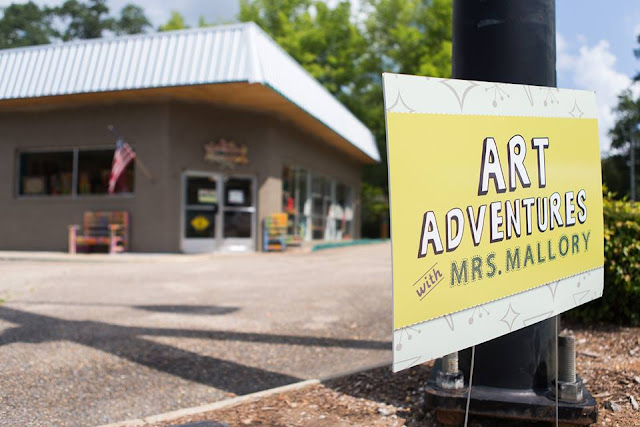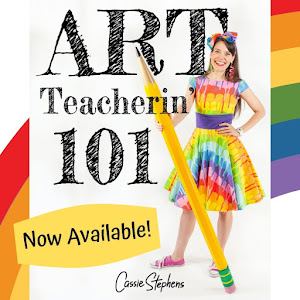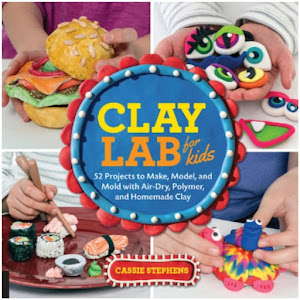Hey there, friends! Today I'm linking you to the third installment of Everyday Art Room, my podcast. You can subscribe wherever you listen to your fave 'casts or simply take a listen right here. I LOVE sharing with y'all in these podcasts...but I also love to hear from you! We have a special feature called Mail Bag where you can send me your questions and I'll answer them in the podcast. You can message me at everydayartroom@theartofed.com. Looking forward to chatting with you. Now, here's the transcript:

A lot of times when I am thinking about my art room and myself as an art teacher, I often think of myself as a student and I go back in time and I just remember what really stood out to me. Either my favorite classroom experiences or my least, my favorite teachers, and how I interacted with them or, better yet, how they interacted with me. Then I also think of my least favorite teachers, because I think there’s a lot of learning that we can as teachers by thinking of those non-example, those teachers who we don’t want to follow in their footsteps. I think it’s important to think of things that maybe we feel they did wrong, how that made us feel, so that we can ensure we don’t have that same experience with the students we teach today.
Today we’re going to talk about consequences and I immediately thought of my sixth grade teacher, Mrs. Kelly. Now, Mrs. Kelly was a nice teacher, I guess, but all I remember really about Mrs. Kelly is that I tormented this poor woman. You have to understand that prior to sixth grade, I was a pretty good student. I did what I was told, I did pretty well in school, I was, I guess what you say, your average kind of kid. I never spoke back, wouldn’t even dream of it. Never took a trip to the office, I would have been flabbergasted. But all of that changed in sixth grade.
I have a teacher friend. She likes to refer to it as kids smelling themselves, meaning they’re getting a little bit full of themselves, feeling a little bit more confident, and testing the waters. Boy, was I smelling myself in Ms. Kelly’s class in sixth grade.
Here’s why. I sensed a weak teacher. When she would come in, she was very scattered, her lessons were all over the place, and she just looked like she was just one step away from completely falling apart. I was like this little animal that sniffed out her weakness and I took complete advantage. It was in sixth grade that I decided to become a standup comedian and I took the stage the moment that she walked in the door, hamming it up for my classmates.
Now, she didn’t have established consequences. Not that I recall. So, her knee-jerk go-to reaction was to put me in timeout. Now, if you teach sixth graders, which I never have, and I don’t plan on it anytime soon, I can only imagine that putting a sixth grader in timeout is just going to backfire in your face. Those middle schoolers are a little bit too wise for that kind of behavior. Now, her idea of a perfect timeout spot was a really bad choice. I was to stand just out of her eyesight behind her in a corner, which meant that when she taught, she couldn’t see me standing in timeout, and you better believe that was the perfect stage for my antics.
I feel really bad for my behavior, but I also know that establishing consequences that, A, fit the crime, B, fit the students and their age and mentality and, C, make sense, meaning don’t put the kids in timeout behind you, I mean, come on, those are some of the things you really have to consider when you’re establishing your consequences.
We chatted about rules last week, today let’s cover those consequences. This is Everyday Art Room and I’m Cassie Stephens.
Today we’re going to talk about the three consequences that I would encourage you to use to enforce your rules in the art room. But, like always with my podcast, before we can address that, we have a couple of other things we’re going to talk about.
The first thing is this. If you have students misbehaving, you have to ask yourself why. To answer that, you need to reflect on your own experiences as a student, just like I did. If you were a cut up, if you misbehaved, you know there were certain teachers that you misbehaved for, whereas there were others who you wouldn’t even dare. Why was that? I think it’s important to think on your experiences as a student because that helps you get into the shoes of your students today.
Before we can talk about those top three consequences that I would recommend that you use in the art room, let’s address some other things first. For example, why do students misbehave? You teach the most exciting class in the school. I mean, come on. It’s art. Everybody loves art. But sometimes every one of us has had to ask these questions. Why are they not following my rules? Why are the students not responding to my directions? And why are they mistreating my art supplies? [Y’all 00:05:55], what did that poor paintbrush ever do to be ground into that painting like that?
I’ve come up with what I believe to be the four main reasons that students misbehave and I think that once you understand why your students are misbehaving, you’ll better be able to craft consequences for your art room. The first thing is this. This is one reason your students might be misbehaving. There’s a lack of a connection with you. Another one is there’s a lack of engagement with the lessons that you’re presenting. Here’s another, and I’m using the word lack again. A lack of having a voice in your art room. Not you, your students. And, last one, there might be a lack of boundaries.
Let’s focus on this before we think about the rules and consequences. Let’s go back to that lack of a connection with you. Your goal in your art room is to build strong relationships with your students. But that’s such a tall order. I mean, some of us are teaching up to 800 kids. We might only see our students on a six-day rotation. It’s hard for us to even learn their names, let alone find out their interests and build a relationship with them. It’s so much easier for a classroom teacher to do this because they see their students every day. So, how can we, as art teachers, build a strong and relasting – Relasting. Listen to me. Lasting relationship. There we go. It’s a relasting relationship with our students.
Here’s what I would recommend in the short amount of time that we have, and in the large amount of students that we also have. Number one, learn their names. I know. I know. You might have a ton of students. But trust me. Knowing your students’ names is the first step in building a relationship and a connection between you and your students. Another one is this. Give your students that positive, happy feeling. It can be any way that makes you and your students comfortable. I’m not really a high five giver. It feels awkward to me, even though I am extraordinarily awkward. But I am a big-time smiler and a winker, and I also love a good old pat on the back. We also do a little sign language of I love you, which also builds a connection between me and my students, but that’s what works for, I always go back to those three S’s, my situation, my students, and my setup. Find what works for you. Lastly, it’s important to really put value in your student’s effort and not value in the talent that they had when they came to your room. That’s really going to help you build a strong connection with your students.
What I mean is this. When you see a student doing a really great job on their piece of art, it’s important for you to praise their progress, praise what they are working on, but don’t let that praise be confused with them as a person. Meaning, “Oh, you’re such a good artist,” can be a little bit damaging, not just to the student you’re saying it to, but also to all the other ears who happen to hear that comment. However, something like, “Wow, you’re really putting so much effort into developing that line for that drawing,” is a lot more specific and encouraging to other students, and this is going to help you build that connection and relationship with your students.
Another thing that might spike misbehavior is a lack of engagement in your lessons. Oh man. We spend so much time coming up with what we believe to be fabulous lessons, or at least we should be spending time to do that. But you have to stop and think when you’re presenting your lessons or when you’re creating them, is this something that’s going to be engaging for my students? Are my lessons exciting and out of the normal routine of my students’ day? For me, for example, I’m just going to say it, I’m not a big fan of crayons and markers in my art room. It is a rare occasion that we use those two supplies, and here’s why. They can use those supplies in their classroom. They can use those art supplies at home. I know you’re thinking, “But Cassie, you need to each them how to use these supplies properly.” Okay. But that doesn’t mean every project needs to based with those same supplies. It needs to be an out of the ordinary and unusual experience when your students come to the art room. Not every time, that’s exhausting, let’s be honest, but keep those lessons exciting, and that will keep your students engaged.
The other one that I was chatting about earlier was a lack of voice in the art room. I often feel like with projects that we sometimes dream up or pin on Pinterest, they look so beautiful, so we have in our mind what we expect the end result to look like, knowing what that end result is going to look like and providing teacher examples that are hung up on the board, which, hey, I’m guilty of. I use those to build excitement for lessons. But keeping up all of the time and having them on display deletes the voice that your students might have when approaching that project. Because what they see is, “Oh, this is my end goal,” not, “Oh, I have a choice with this project.”
The last one is a lack of boundaries. This is the flip side of what I just said. Sometimes if you build up too many boundaries and make a lesson too constraining, you’re not offering choice. Then on the flip side of that, if it’s too wide open, then there are no boundaries. Not having boundaries established in your art room, and in your lessons, and in your day-to-day routines can really set you up for art room disaster.
Now that we’ve established why students might misbehave, a lack of boundaries, a lack of choice and voice in the art room, a lack of engagement and a connection with you, now let’s address consequences. Consequences are the result of a rule being broken. That’s what a consequence is and that’s what you need to tell your students. Keep it short, simple, and sweet. Guys, consequences are the result of a rule being broken.
Now, last time we chatted about the rules for the art room and I explained that my rules for my art room are based on the word art. Just to review, the A in art stands for aim, the R stands for respect, and the T is for trust. In aim, I want my students to aim to do their best and aim to do the right thing. The R, respect, is respect yourself, respect your classmates, respect the art room. Then the T for trust is trust in yourself and, here’s another one that’s really important to me, trust in your ability to learn. Now, these rules of mine are very broad. They’re also a little conceptual, which can be tough for students to comprehend. Because they are vague and because they might be difficult for students to understand, it’s so important to review the rules a lot that first month and more of school, and to explain, offer role playing. What I plan to do is craft videos that will better help my students understand my rules. But they also have to know that when a rule is broken, there are consequences.
What do my three consequences look and sound like? Let’s talk about it. Let’s start with the warning. What’s a warning? A warning for me in my art room is a gentle reminder to my students that a rule or a routine has been broken. What does that sound like in my art room? I try really, really hard to use the same tone of voice, the same phrase, and the same approach every time I deliver a warning, and here’s why. I’m trying very hard not to waste my students’ time and I’m trying very hard to be consistent, which I struggle with, so I try very hard to use that same tone and verbiage when I’m delivering my warning. It sounds like this, “You have a warning because” and then I tell them what rule or routine they have broken. I leave it just like that. I deliver the message, I look them in the eye, I offer my “You have a warning because”, and I leave it at that.
Now, like I said, the beginning of the school year and with my younger students, I usually will deliver two warnings before I move on to timeout. I don’t tell them that. I just deliver that warning. It’s not a conversation. It ends when I stop talking, meaning I do not expect a response from my students. If they give me a response, then I will issue that very same sentence again. If an argument on their end starts to develop, then we will move on to the second consequence. One thing you need to make sure to do when you’re delivering your consequences is never lose your cool. Remember that ’80s commercial, never let them see you sweat. Never lose your cool. Be completely consistent delivering the same sentence in the same tone of voice, in the same calm manner every single time. After a while, they’re going to realize, “Oh my gosh, she is just going to keep repeating this same sentence over and over again in the same manner and in that same creepy, calm voice, so I might as well get my act together.” That’s consequence number one, the warning.
Let’s talk about consequence number two, timeout. I have used timeout in my room since the beginning of art teachering time, and it’s changed over the course of my teaching. Here’s why. I used to have my students move to a different spot in the room. Remove them from where the activity is. I will be honest, usually my students need to take a timeout break during our beginning of the art class circle time. It usually happens because I have a student who’s very excited or distracted by their neighbor and cannot seem to focus, so I need to remove them from the group. And I used to do that. I used to have a small desk and it was on the other side of the room. I could see this child clearly but they were removed from the situation. I have long since stopped doing that and here’s the number one reason why. When that student would come back and join the group, they often had missed a large part of an instructional time, which meant that I then had to go back and reteach them, neglecting the other kids in the room.
I no longer have a timeout place that’s far away from instruction. Instead, here’s where my timeout is. Imagine this in your mind. My students, when they come to art, they join me on the floor. Like I said, if I have to put a student in timeout, it usually happens during this time, this instructional time, which really isn’t saying much about my instruction by the way. Maybe that’s something I need to think about. Regardless, I have two little taped X’s on the floor in my art room, right behind where my students are seated to listen. If I have a student that needs to take a timeout break, I simply say, “You need to take a timeout because,” I tell them the routine or rule they broke, they know to go and stand on that X.
Here’s why I do this. Number one, they stand because I do not want them to be comfortable. You’re not in timeout because I’m really thrilled with what you’ve been doing. You are in timeout to stand up properly, give me your full attention, and show me you want to come back to the group. All of that is explained and demonstrated on those first couple of days of school.
Another reason I keep my students close when they are in timeout is so they can continue to get all of the information that their students … I’m sorry. That their peers are also getting. That way, they don’t miss out on any instructional time.
I don’t have a set time. I don’t set a timer. I don’t say to my students, “You’re going to be in timeout for five minutes.” I simply tell them to go to timeout. When I’m establishing my rules and routine, I let them know that in order for them to come out of timeout, they need to demonstrate with their body and their listening skills that they are ready to join the group. Usually, so that I don’t call attention to them, I can tell by their body language and the fact that their eyes are on me, that they’re ready to join us, and I simply wiggle my fingers a little bit to let them know it’s okay for them to return to the floor. They almost always do so very quietly. That’s how I operate timeout.
Now, let’s talk about the third one. You’ve gone through warning after warning, you’ve sent your sweet friend to timeout numerous times, and now it’s time to really go to number three. For me, the third consequence, to send students to the office, is what works best for me, my situation, my setup, and my students. I have a very supportive principal and administration and I know that if I send a child to the office, which happens once a year maybe, so this is a very rare occurrence, I know that if I send a student to the office, they’re going to take it very seriously. That might be different for your situation. It might be better for you to reach out to a parent or to talk to the child’s teacher. So really think hard about what will give you the best results when you have a student that’s very difficult to manage their behavior in your art room. Again, think about your setup, situation, and students. We all are different art teachers, so we really need to think about what’s going to work best for us.
That’s how I handle consequences in my art room. Like I said, that’s something that I start teaching about from day one, demonstrating what I’m expecting, and what can happen if my students don’t give me what I’m expecting in my art room. If a rule is broken, there are consequences. Remember to always deliver them calmly and consistently, and you’ll be extremely happy with the results.
Tim Bogatz: Tim Bogatz here from Art Ed Radio. A quick reminder that you can find resources, links, and a full transcript of each show on the AOE website. Just click on the podcasts tab and select Everyday Art Room. If you’re loving Cassie’s podcast, please submit a rating and a review on iTunes. This helps other art teachers discover this amazing show. I also want to tell you about Art Ed PRO, the essential subscription for professional art teachers. It is on demand professional development with video tutorials, downloadable handouts, and all kinds of other resources that will help take your teaching to the next level. The PRO library has over 40 topics, with three new topics released every month, from assessment and curriculum, down to teaching your teens, and firing your kiln. It is the professional development you need, when you need it. Make sure you check it out at the ArtOfEd.com/Pro. Now let’s get back to the show.
Cassie: Now it’s time to take a little dip into the mailbag. This question I know lots of you guys can relate to. “Cassie, what do I say or do when all these classroom teachers come to me for art supplies?”
Oh, that’s a big one because I know all of us have been in that kind of situation. Let me tell you how to kind of think about it before you answer that question. First of all, think about it this way. Your art supplies are for the art education of your students. Your art supplies are not for the general education of your students. When you think about it that way, it might better help you say no to those requests for paint, or glue, or paintbrushes, or scissors. When you start donating those things out as if your art room were a craft supply store, you are neglecting the art education of your students.
When you have a teacher asking for, oh, just a little bit of paint, and you know it’s always like two minutes before they need it, right when you’re in the middle of teaching a lesson, I mean, let’s be honest, it’s okay for you to say no. “I am so sorry. I would love to help you with that, but these art supplies have been purchased for the art education of my students. And with my budget, I don’t have any to spare.” It’s okay for you to say no. You are the voice for your students’ art education. Perhaps thinking about it that way will help you better say no.
If you guys have any questions for the mailbag, please feel free to send them our way at everydayartroom@theartofed.com.
Wow. This episode on consequences really was a meaty one, but you can tell that consequences are just as important as the rules you establish for your art room. Remember, before you think of the consequences for your art room, remember to think about your situation, your setup, and your students. Also, think about why your students might be misbehaving and that might inspire you to do some reflection of yourself as a student. Put yourself in their shoes. Remember, it might be because there’s a lack of a connection with you, which your students crave, a lack of engagement or excitement in your lessons, perhaps there’s a lack of voice on your students’ behalf in your art room, or, on the flip side, maybe there’s a lack of boundaries.
Once you’ve kind of sifted through those thoughts, then you can establish your consequences. They might be different than mine but mine are as simple as this. Number one, a warning. Two, timeout. Three, a visit to the office, which, like I said, is an extraordinarily rare occurrence. Remember, when you are delivering your consequences, do so in a consistent, using the same phrase and sentence every time, and in a very calm manner. Consistency and calmness are key to establishing those consequences in your art room.




































































